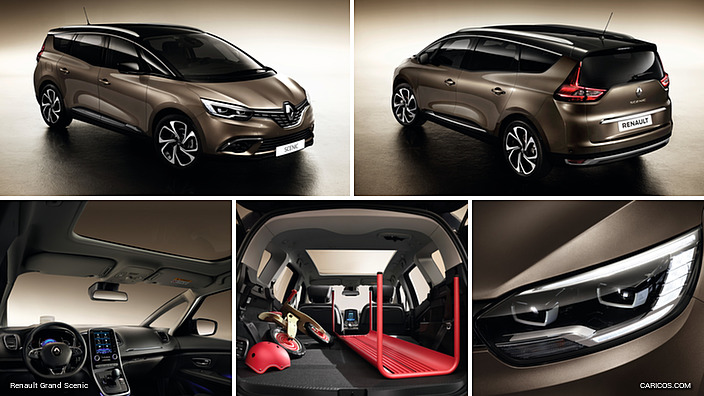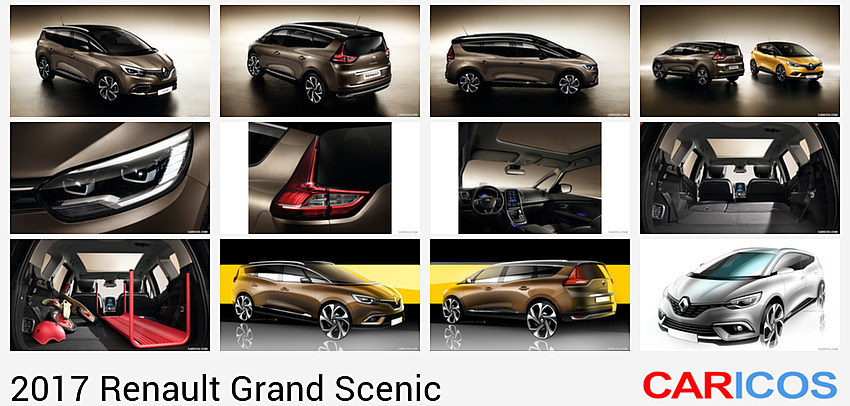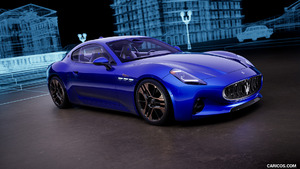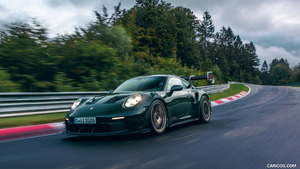Renault Grand Scenic
Twenty years after inventing the world’s first compact MPV (multi-purpose vehicle) with the Scénic – which has since sold to the tune of almost five million units and which was named European Car of the Year in 1997 – Renault has completely overhauled its offering in this segment with the fourth generation of its iconic model.
Unveiled at the Geneva International Motor Show in March 2016 in its short version – with the long version appearing two months later – the thoroughly ground-breaking design of the new SCENIC compared with previous-generation versions is the very last word in seductive appeal.
At the same time, the new SCENIC carries over the hallmarks that helped to forge its success, namely versatility, space, user-friendliness and travelling enjoyment.
The new SCENIC stands out as a game-changer in the realm of MPVs as a vehicle that is uncompromisingly desirable, practical, efficient and high-tech, while also meeting the needs of families:
- Desirable in terms of its svelte yet powerful silhouette, its head-turning two-tone colour scheme and the fitment of large 20-inch wheels as standard across the range – a global first for the segment,
- Practical, thanks to the biggest stowage capacity and boot space in its class*,
- Efficient, courtesy of a broad range of powerplants comprising six diesels and two petrol engines, with the corerange diesel version incorporating Renault’s new Hybrid Assist technology,
- High-tech thanks to a raft of driving aids and other features, such as its Active Emergency Braking System (AEBS) with Pedestrian Detection – a standard feature across all equipment levels.
In both its short and long guises, the fourth-generation SCENIC is firmly focused on winning over loyal owners of its three previous generations who have long been drawn by the innovative features of the model which introduced the first sliding centre console. At the same time, its striking design and performance credentials are poised to attract new customers.The new SCENIC is targeting private buyers as well as companies in search of a competitive total cost of ownership.
 2017 Renault Grand Scenic
2017 Renault Grand Scenic
Groundbreakingly seductive styling compared with previous-generation versions
“We wanted the new SCENIC to break new ground. It is a sexier and more modern take on the MPV, which carries over the outstanding modularity that has been paramount to the success of the model’s three previous generations over the past 20 years. Its proportions and large-diameter wheels draw inspiration from the R-Space concept car.”
Laurens van den Acker - Senior Vice-President of Corporate Design, Renault
Reinvented dimensions and design
In both its short and long versions, the new SCENIC offers:
- A distinctive MPV body shape that is 20mm wider than the Scénic 3, along with higher ground clearance (+40mm), a longer wheelbase and wider tracks at both the front and rear. The rear overhang, meanwhile, has been shortened by 16mm to reinforce the appeal of the vehicle’s fluid silhouette.
- A steeply-raked panoramic windscreen offering enhanced vision to the sides.
- A panoramic glass roof (optional).
- A specific lighting signature as standard (as on the rest of the range), with C-shaped front lights and 3D-effect taillights incorporating Edge Light technology; the new SCENIC’s taillights are horizontal on the short version and vertical in the case of the long model.
- A two-tone colour scheme.
NB: The long version of the new SCENIC is equipped with aluminium roof bars.
Unprecedented 20-inch wheels
A world first in the new SCENIC’s segment: the fitment of 20-inch wheels as standard across the model range: in addition to ensuring a unique silhouette, big wheels add to the new SCENIC’s dynamic stance by making the roofline appear lower.
The unprecedented ratio between the size of the wheel and the height of the beltline imbues the new SCENIC with a dynamic, balanced stance.
The fitment of 20-inch wheels fills the new SCENIC’s wheel arches, much like those on a sports car. Last but not least, to customise the new SCENIC’s rims, screw-on inserts are available as an add-on for even greater style and distinction. This initial selection will be extended gradually.
Innovative 20-inch wheels for enhanced comfort and road holding
“After the revelation of the R-Space concept car, Renault engineers and designers worked hand in hand to make sure that the visual appeal of 20-inch wheels was compatible with the very highest standards in terms of safety, comfort, fuel consumption and running costs. After four years of work, and thanks to the outstanding collaboration we enjoyed with our tyre manufacturer partners, we are very keen to see our customers benefit from this innovation.”
Irina Zaretskaya - Deputy Programme Manager, New SCENIC
Safety and comfort amongst the very best in the new SCENIC’s class
The new SCENIC’s longer wheelbase (short version: +32mm / long version: +34mm compared to Scénic 3) delivers outstanding road holding which has been enhanced by the fitment of 20-inch wheels (195/55R20) which position the model amongst the very best in its class when it comes to road manners and braking performance, without detracting from ride comfort.
The car has successfully passed all the industry’s collision avoidance tests (VDA, ADAC, GLENNING and ISO), both with and without ESC (Electronic Stability Control).
Meanwhile, the new SCENIC’s braking performance has been improved compared with the third generation of the model. On dry roads, stopping distances from 100kph and 130kph are down three and five percent respectively. In the wet, the gain over the former Scénic from 80kph is five percent.
In order to strike the optimum balance between comfort and performance, Renault has deliberately equipped the new SCENIC with tyres whose sidewalls (107mm) are higher than those of the majority of 17- or 18-inch tyres. The extra comfort provided by these high sidewalls combines with that resulting from improvements to the new SCENIC’s wider seats which provide better lateral support. The use of dual-hardness foam is another unquestionable plus.
The single wheel size across the range has also allowed the chassis to be perfectly tuned and adapted to deliver both first-class comfort and engaging handling. Renault’s engineers have worked closely with tyre manufacturers on the efficiency of the new SCENIC’s tyres and suspension configuration which features MTV (multi-tuned valve) dampers.
The new SCENIC’s wheels consequently soak up imperfections in the road surface more effectively to provide occupants with even greater comfort, wherever they are sitting in the vehicle.
Putting the environment and keeping costs to a minimum first
Twenty-inch wheels enable the new SCENIC to boast the best possible environmental credentials thanks to the combination of three key factors:
- Low friction: the wheels are no wider than 16-inch rims (195mm).
- Optimised aerodynamics: thanks to the fitment of narrower tyres, the new SCENIC’s low CdA (drag coefficient, the second most significant factor in terms of the environment, after the vehicle’s weight) translates into a 2g/km saving in terms of CO2 emissions in comparison with the previous-generation Scénic.
- The use of low rolling resistance (LRR) tyre compounds.
The result is that in the context of the EU’s tyre labelling system – which classifies tyres as a function of their rolling resistance – the new SCENIC’s wheels achieved an ‘A’ rating, the best score ever awarded to 20-inch wheels.
Although bigger, the new SCENIC’s 20-inch tyres do not engender any additional cost. Indeed, they are priced at the same level as the 17-inch summer, winter and all-season tyres available for the Scénic 3. Furthermore, the tall sidewalls lessen the risk of rim damage.
The new SCENIC’s tyres can also be fitted with snow chains, the cost of which is in line with the market norm.
Twenty-inch tyres readily available across the network
Purchasing replacement 20-inch tyres for the new SCENIC is no different to buying other tyre sizes for Renault models. Twenty-inch tyres will be available the day after the order is placed across the dealer network, or the day after that if ordering via Renault sales agents.
Outstanding modularity, with record-breaking stowage and boot space
“As the ultimate family vehicle, the new SCENIC has reinvented itself to offer families a thoroughly modern and attractive incarnation of the traditional MPV. Travelling comfort has always been firmly rooted in the SCENIC’s DNA, and the model remains as unique and impressively practical as ever for all occupants thanks to its superb modularity.”
Pauline Sapy-Renaudin - Product Marketing Manager, new SCENIC
More versatile than ever
- The new SCENIC’s One Touch Folding rear seats – a feature carried over from the new Espace – can be folded effortlessly to achieve a flat floor. The model is the only vehicle in its class in which this function can be activated from two different places: from inside the boot or by using the R-LINK 2 system.
- The new SCENIC is similarly the only vehicle in its class to boast a large, sliding centre console with 13 litres of stowage space, a capacity that is up to four times that of any of its competitors.
For front occupants, the console provides a lit stowage area protected by a sliding cover, plus an integrated armrest, underneath which can be found two USB ports and an audio jack socket. The rear is equipped in exactly the same manner, in addition to a 12-volt power supply and a dedicated stowage compartment. When the centre console is in the forward position, it creates a welcome stowage space for the driver and front passenger; when it is in its rearmost position, it acts as a partition between the front and rear seats – a particularly practical feature when children are travelling in the back!
Record carrying capacity
The new SCENIC has a boot capacity of 506 dm3 VDA (572 litres). This is the largest volume in its class and compares very favourably with the average capacity (469 dm3) of its rivals.
When configured with just five seats, the seven-seat version of the new GRAND SCENIC offers 533 dm3 VDA (596 litres) of carrying space, which places it second in its class.
The five-seat version of the new GRAND SCENIC boasts 718dm3 (VDA) of boot space (765 litres).
The new SCENIC similarly tops its class when it comes to stowage space. In addition to its 13-litre centre console, it is equipped with an 11.5-litre lit and chilled ‘Easy Life’ drawer, which offers up to more than three times the carrying capacity of rival models. It opens by means of an electronic sensor and automatically locks when the vehicle stops.
Other ingenious stowage solutions, including four underfloor compartments, extend total stowage capacity to 63 litres, placing the new SCENIC at the top of its class by offering up to twice as much space as its competitors.
Technology from the next segment up
“In addition to its assertive personality, the new SCENIC is also innovative and foreshadows Renault’s strategy with regard to connected and autonomous vehicles. Its different sensors and cameras enhance safety and travelling comfort, while its multimedia technologies facilitate the control of the different systems.”
Cécile Sobole - Product Manager, New SCENIC
A wealth of safety- and comfort-enhancing equipment
The new SCENIC and new GRAND SCENIC notably feature:
- Colour head-up display,
- MULTI-SENSE technology, which grants access to five different driving settings: Neutral, Sport, Comfort, Perso and Eco,
- R-LINK 2 complete with a portrait-format 8.7-inch display that is amongst the largest in the segment. From January 2017, R-LINK 2 will be able to link to Apple CarPlay and Android Auto functions,
- Bose® Surround Sound audio.
The new SCENIC and GRAND SCENIC similarly boasts all of the market’s major driving aids that can be found in the new Espace, the Talisman and the new Mégane. These Advanced Driver Assistance Systems (ADAS) – which can be accessed and activated via the R-LINK 2 tablet – combine to provide the following functions:
- To reassure: Adaptive Cruise Control (ACC, operational between 50 and 160kph) and Active Emergency Braking System (AEBS). In the new SCENIC, AEBS also works at low speeds, operating between 7 and 160kph,
- To alert: Lane Departure Warning (LDW), which is haptic in the new SCENIC (i.e. it causes the steering wheel to vibrate rather than emitting an audible alert); Safe Distance Warning (SDW); Traffic Sign Recognition with Over Speed Prevention (TSR with OSP); Blind Spot Warning (BSW),
- To assist: reversing camera; automatic dipped and main beam headlights (AHL); front, rear and side parking sensors; and Easy Park Assist (hands-free parking).
Three new driving aids
In addition the ADAS listed above, the New SCENIC and New GRAND SCENIC feature three new ADAS. Uniquely in the segment, the Active Emergency Braking System (AEBS) with Pedestrian Detection is a standard feature of the new GRAND SCENIC.
This function works across a speed range from 7 to 60kph.
- It analyses the environment around the vehicle by monitoring both stationary and moving pedestrians and predicting their intended path.
- It alerts the driver to the risk of a collision between the vehicle and a pedestrian.
- It automatically applies the brakes and brings the vehicle to a complete standstill should an imminent risk of collision with a pedestrian be detected and if prior warnings fail to trigger a response by the driver.
In addition to AEBS with Pedestrian Detection, the new SCENIC and GRAND SCENIC offers two other new innovations for Renault vehicles:
- Lane Keeping Assist (LKA), which is active at speeds between 70 and 160kph. Should the driver inadvertently allow the vehicle to drift, this feature automatically assumes control of the steering to keep the vehicle in its correct lane.
- Tiredness Detection Warning (TDW): the vehicle’s path is constantly monitored by a Bosch-developed algorithm, providing both visual and audible warnings should driver fatigue be suspected.
A five-star Euro NCAP rating for the new SCENIC
The new SCENIC has achieved Euro NCAP’s highest score of five stars for passive safety which rates the structural elements and equipment that protect occupants when a collision cannot be avoided.
The new SCENIC’s platform employs reinforced steels for the main beams, side rails and windscreen pillars and B posts to protect occupants inside the survival cell. Some of them are ultra-high elastic limit steels and are capable of withstanding loads of up to 120kg/mm2. Meanwhile, the use of programmed deflection steels outside of the cabin enable impact energy to be absorbed while keeping the survival cell intact.
The new SCENIC is equipped with two curtain airbags for the front and second-row seats, plus two thorax airbags at the front and two latest-generation adaptive front airbags which use sensors to adjust their deployment as a function of the occupant’s build.
An extensive engine range, including Hybrid Assist
Six diesel and two petrol powerplants
The new SCENIC range provides a choice of six diesel engines, mated to either a six-speed manual gearbox or to six- or seven-speed EDC (Efficient Dual Clutch) automatic transmission, plus two petrol engines which drive through a six-speed manual gearbox.
The list of available engines includes:
- The Energy TCe 130 (petrol) which delivers powerful performance thanks to its turbocharger. It is responsive at low engine speeds and combines low fuel consumption with acclaimed driving enjoyment.
- The Energy dCi 160 EDC (diesel). This responsive, sprightly and nicely-balanced package packs Twin Turbo technology and boasts peak power of 160hp. It is mated to six-speed EDC dual clutch automatic transmission for even greater pleasure behind the wheel. In addition to its uncompromisingly low fuel consumption for its power output, it is smooth, dynamic and particularly efficient.
- The Energy dCi 130 (diesel). Mated to a six-speed manual gearbox, this 130hp powerplant is especially suited to everyday motoring and meets the needs of owners who are looking for economy while still being treated to first class driving enjoyment.
Renault’s new Hybrid Assist technology
“With Hybrid Assist, Renault has drawn upon its electric vehicle expertise to deliver technology that fits perfectly with its electrification strategy. We are committed to continuing to provide the broadest spectrum possible of motorists with innovative solutions that yield significant reductions in fuel consumption while keeping additional costs to a minimum. Hybrid Assist provides a first-class eco-driving experience without compromising on driving pleasure.”
Philippe Cotté - Project Leader, Application of Hybrid Assist to existing engines
The new SCENIC breaks new ground by offering Renault’s innovative Hybrid Assist engine electrification technology which is available with the model’s core-range dCi 110 diesel unit and mated to a six-speed manual gearbox.
The electric motor is powered by a 48-volt battery which takes over some of the work of the internal combustion engine to provide low fuel consumption and CO2 emissions without compromising the driving enjoyment and pick-up performance delivered by the dCi 110 engine.
During deceleration, the motor generation unit MGU recovers energy for use by the vehicle’s electrical system and for storing in the system’s independent battery. It also serves as a 10kW motor which functions in association with the internal combustion engine when the driver re-accelerates.
The technology provides up to 15Nm additional torque in certain situations.
Hybrid Assist allows fuel consumption and CO2 emissions to be reduced by approximately 8 to 10 percent in comparison with the standard dCi 110 engine.
With comparable powerplants under the bonnet of the new SCENIC, fuel consumption falls from 3.9 to 3.5 litres/100 kilometres, equivalent to CO2 emissions of 92g/km instead of 100g/km.
Hybrid Assist is a driver-friendly feature since it is maintenance-free and functions independently. It also benefits from the considerable experience Renault has acquired in the realm of electric vehicles. In offering this new technology for the new SCENIC’s mainstream engine, and at such an affordable price for a pioneering hybrid solution, Renault has successfully achieved its objective of making Hybrid Assist a widely accessible innovation.
THE NEW SCENIC MADE IN DOUAI, FRANCE, LIKE THE TALISMAN AND THE NEW ESPACE
The new SCENIC and the new GRAND SCENIC are both made at Renault’s Douai plant in France, alongside the Talisman and the new Espace.
When the new Espace was launched in 2015, the factory benefitted from expert recommendations from Daimler to upgrade certain aspects of its manufacturing processes. Meanwhile, producing the new Espace and the new SCENIC on the same line enables innovations such as their automatic seat folding system to be shared.
The Douai plant has invested in a new light booth in the paint shop for improved colour matching.
A LOOK BACK AT THREE GENERATIONS OF RENAULT’S COMPACT MPV, A BENCHMARK FOR TWO DECADES
The Scénic, which was the European automobile industry’s first compact MPV, is celebrating its 20th anniversary in 2016. Successive generations of this Renault ‘invention’, sold in nearly 5 million units, have introduced fresh thinking and evolutions while continuing to deliver the concept’s original pledges, namely travelling comfort, useful technology, safety and responsible performance.
1996-2003: “An invitation to travel”
The first-generation Mégane Scénic was unveiled in 1991 in the shape of a concept car at the Frankfurt Motor Show. Following Espace, the high-end minivan launched in 1984, and Twingo, the minivan-styled city car launched in 1993, Renault confirmed its frontrunner status with Mégane Scénic. Launched officially in 1996, it is considered as the first model in the compact minivan category.
2003-2009: the pioneer confirms its leadership
Following the success of the first generation, the compact minivan idea was widely reproduced by other carmakers and Scénic now had to compete with rivals including the Opel Zafira and Citroën Xsara Picasso.
Scénic II maintained the brand’s advantage in a segment where it has been a standard-setter since 1996 and in which it has never relinquished its leadership.
2009-2016 : focus on travelling comfort
The third-generation Scénic and Grand Scénic made their debut in March 2009 at the Geneva Motor Show. In a changing world, Scénic and Grand Scénic adapted to the expectations of customers, bringing them even more comfort and motoring pleasure.
From the R-Space concept car to the new SCENIC
In 2011, Renault presented the R-Space at the Geneva Motor Show. This concept-car took the compact MPV into a new era by combining the requirements of family use with sensuous, sporty styling and a functional design. The whole mirrored the modern family which has many different needs but which aspires to a vehicle that is both stylish and user-friendly.
The R-Space’s lines were taut, with sleek, slender side windows, while the cabin was spacious and welcoming, with ‘interwoven’ front seats and the rear designed as a modular play area, filled with 27 coloured children’s building blocks. The three-cylinder, 900cc Energy TCe engine delivered a power output of 110 horsepower and drove through dual clutch EDC transmission.
The R-Space, which revisited Renault’s famous ‘Voitures à Vivre’ philosophy, served as the inspiration for the fourth-generation Scénic which was revealed at the 2016 Geneva Motor Show at the beginning of March.















